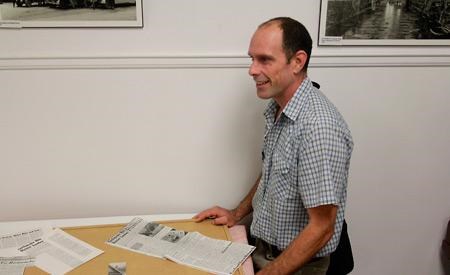On October 18 at 10:18 am over 4,000 Powell River residents will drop to the floor, find some cover and hold on as they participate in the annual Great British Columbia ShakeOut.
They will be joining over 470,000 British Columbians who are registered in the earthquake drill organized by BC Earthquake Alliance. History has shown that for coastal British Columbia, earthquakes are not a question of “if” but a question of “when.”
The Great ShakeOut initiative started in Southern California in 2008 and quickly spread throughout the western and central United States and includes prefectures of Japan, the island of Guam and British Columbia. This year is the first time that all locations will hold the drill at the same time and over 9.6 million people living in the Pacific Standard Time zone will participate.
The purpose of the voluntary drill is to raise awareness about earthquake preparedness and encourage people to practice what to do to stay safe during a big shake.
Ryan Thoms, coordinator for Powell River Regional Emergency Program, explained the procedure to stay safe no matter the size of the shake. He said to drop to the floor and either find a table or some other furniture for protection from falling debris and then hold on until the shaking stops.
“Everyone’s first reaction to being inside of a building when it starts shaking is to run out,” said Thoms. “Drop, cover and hold on is somewhat counter intuitive.”
He said it’s not worth taking the risk to get out of a shaking building. “You’ll just trip and fall down the stairs,” he said. “You’re just going to hurt yourself.”
A minor earthquake is unlikely to topple or collapse wood-frame homes, he said, and during a large earthquake the shaking will be so severe that it will be too difficult to get anywhere anyway. Injury prevention is important because the emergency services that people rely on may be so overwhelmed by the surge in need that people will have long waits for help, he said.
The threat of the “Big One” looms large for residents up and down the Pacific coast. These quakes happen below the ocean floor off the west coast of Vancouver Island where the Juan de Fuca plate is slowly being forced beneath the North American plate.
However, Dr. Steve Earle, chair of the earth science department at Vancouver Island University, said it isn’t these expected earthquakes that we should worry about the most. Rather, it is the more unexpected ones, like the 1946 earthquake located somewhere on the Forbidden Plateau on Vancouver Island, that are cause for thought. It holds the distinction of being Canada’s largest recorded on-shore earthquake. At a magnitude of 7.3 it rocked Powell River and was felt as far north as Prince Rupert and as far south as Portland, Oregon.
“I think there’s reason to be more worried about an earthquake like the 1946 one than big subduction zone earthquakes for a couple of reasons,” said Earle. “It’s more likely to happen sooner, although we don’t know what kind of interval there is between those kinds of earthquakes. It’s likely that it’s shorter than the interval for the big earthquakes.
“The other reason is that it would be a lot closer in distance across land, and also it would be a shallower earthquake,” he said. “It’s likely to have more of an impact on Vancouver Island, Powell River and even the Lower Mainland than a really big earthquake.”
While geologists are not sure the exact location of the 1946 earthquake’s epicentre, Comox, Port Alberni and Powell River residents are sure about its effects. About 75 per cent of homes in the Comox Valley lost their chimneys that June morning and the facades of storefronts crumbed and landed on sidewalks and streets. More than 300 landslides were triggered by the shaking and there were reports of liquefaction, a state where the ground becomes like quicksand due to the intense shaking, along the east coast of central Vancouver Island. Some of these landslides caused small localized tsunamis.
Thoms said that time played an important factor in the number of injuries and fatalities. It was Sunday morning, children were not in school and there were few people walking on city streets. It was summer so few homes had fires lit that could spread when houses were dislodged from their foundations and chimneys crumbled.
“When you look at the pictures after the quake,” he said, “the buildings were still standing. If you go running outside, you’re likely to meet your chimney falling on the way.”
More information about earthquake preparedness and how to register for ShakeOut BC is available online.



